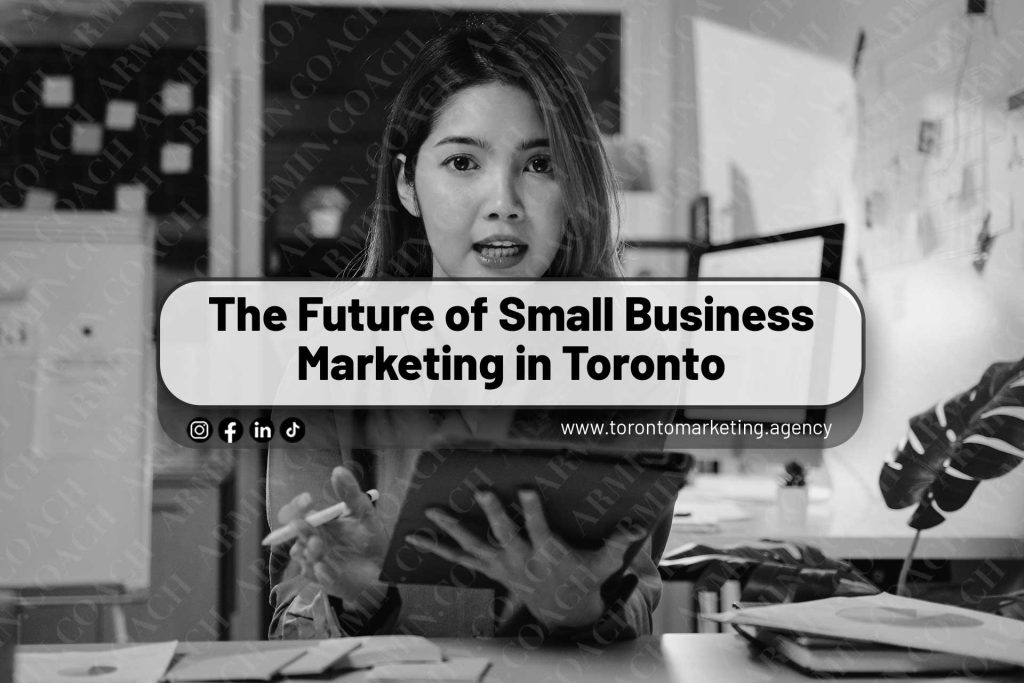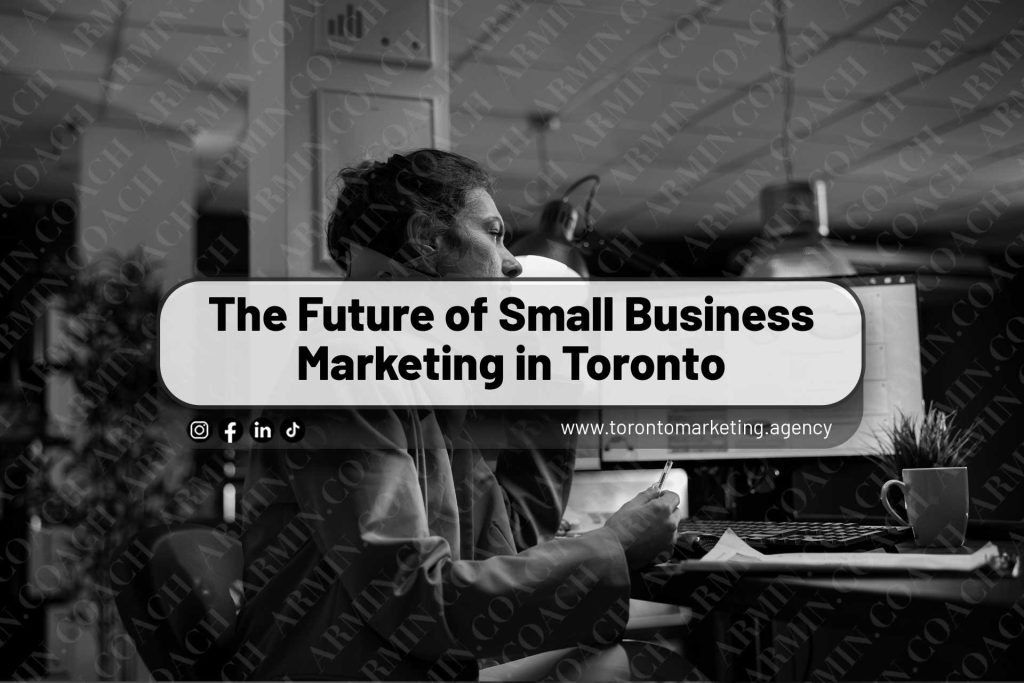1.Toronto’s Unique Marketing Ecosystem
Toronto is a mosaic of neighborhoods—Yorkville, East York, North York, Scarborough, the Beaches, the Junction, Leslieville, and dozens more. Within each, consumer preferences, cultural identities, local hubs, and media patterns differ drastically. A message that resonates in Riverside may not land the same way in Etobicoke.
Small businesses in Toronto compete on multiple fronts: with local neighbours, regional chains, national brands, and increasingly, e-commerce players. In this crowded environment, marketing in Toronto must deliver precise relevance, emotional resonance, and frictionless execution.
As technology evolves and consumer habits shift, small businesses in Toronto must be nimble. The future belongs to brands that can adapt quickly, align with local values, and harness emerging tools to capture attention, loyalty, and community trust.
In the sections below, we’ll map out that future in actionable, grounded detail.
2. Key Trends Shaping the Future of Marketing in Toronto
2.1 AI, Machine Learning & Automation
Perhaps the biggest shift on the horizon is the integration of AI-powered marketing tools into everyday operations even for small businesses. AI is no longer just a buzzword for large enterprises; many SMBs are already leveraging it to automate copywriting, campaign generation, personalization, chatbots, and analytics.
- According to a Salesforce SMB Trends Report, three out of four small businesses are already investing in AI, and those growing are nearly twice as likely to adopt it. Salesforce
- MarketingProfs reports that small businesses are blending new tech and traditional channels to deepen customer relationships. MarketingProfs
- A broader view: SMBs increasing tech spend show stronger performance, using AI for automated marketing campaigns, self-service chatbots, and smarter sales workflows. Salesforce
How this plays out for Toronto:
- AI tools will allow small brands to produce localized, highly personalized content (ads, emails, landing pages) with minimal overhead.
- Smart automation will reduce repetitive tasks (scheduling posts, reporting, segmentation), freeing up creative bandwidth.
- Predictive analytics will help forecast foot traffic, local demand, and optimal campaign timing.
- AI chatbots, integrated with Toronto-specific context and data, can handle customer queries 24/7, with local relevance (e.g. store hours, neighborhood terms, Toronto slang).
Risks & caveats:
- Overreliance on AI-generated content can feel generic or hollow if not guided by brand voice.
- Data bias or automation errors may misinterpret inputs.
- Privacy and regulatory compliance must be built into AI deployment (especially with Canadian data laws).
In short: AI will be a core enabler for marketing in Toronto, but must be wielded strategically.
2.2 Hyperlocal & Neighborhood-Level Targeting
Toronto is a city of microzones—each neighbourhood has its identity, local influencers, foot traffic patterns, and channels of influence. The future of marketing for small Toronto businesses will lean heavily on hyperlocal strategies.
- Rather than broad “Toronto-wide” campaigns, brands will invest in neighborhood-specific messaging (e.g. “Best café in Junction,” “Local favourite in Leslieville”).
- Geofenced ads and hyperlocal mobile campaigns will deliver messaging only to people physically within a few blocks.
- Local partnerships with community groups, street associations, and block-level media (neighbourhood newsletters, bulletin boards, local radio) will gain renewed importance.
- Micro-influencers with trusted local followings (e.g. a popular Instagrammer in Danforth Village) will drive more engagement relative to macro influencers.
- User-generated content from nearby customers will be leveraged to amplify social proof: “Lives in Toronto → loved our product.”
This hyperlocal focus helps small businesses be more relevant, efficient, and memorable in their immediate surroundings.
2.3 Experiential & Immersive Marketing
In an age of ad fatigue, physical and immersive experiences offer a way to make a brand come alive. For small business marketing in Toronto, this will be a key differentiator.
- Pop-up stores, installations, or mini-events in high-foot-traffic zones (Queen West, PATH, Yonge) let customers experience the brand in real life.
- VR/AR activations: e.g. scan a QR code in a store window to preview product placements or interactive visuals.
- Collaborations with Toronto festivals (Pride, Nuit Blanche, Local music/arts fests) to host branded experiences.
- Street art or murals tied to brand identity and designed to encourage social sharing (Instagrammable installations).
- Local brand ambassadors or street teams engaging with passersby to hand out samples, swag, or spark conversations.
These experiences create emotional connections and memos in the brain turning fleeting exposure into memory and word-of-mouth.
2.4 Short-Form Video, Social Commerce & Content Evolution
The shifting media diet of consumers demands new formats. In Toronto, small businesses must embrace this shift to stay relevant.
- Short-form video platforms (TikTok, Instagram Reels, YouTube Shorts) are surging in engagement. Digital trends in Canada suggest strong growth for such formats in 2025. digitales.ca
- Social commerce: shoppable posts, in-app checkout, Instagram/Facebook shops conversions without leaving the platform.
- Interactive content: polls, quizzes, AR filters (e.g., filter that shows your product on the user in Toronto).
- Live commerce or broadcasted “live shopping” events targeted to Toronto audiences or time zones.
- Episodic content series focusing on Toronto themes (local trends, behind-the-scenes, community tours) build sustained awareness.
This evolution in content means future marketing in Toronto will demand agility, storytelling, and cross-format fluency.
2.5 Sustainability, Ethics & Purpose-Driven Branding
Consumers today expect brands to reflect values, not just sell products. For small businesses in Toronto, purpose-driven marketing will be central.
- Toronto consumers increasingly prefer brands that commit to sustainability, equity, and local impact.
- Transparent supply chains, eco-friendly packaging, community causes, and ethical practices can become unique differentiators.
- Partnerships with local non-profits, cultural organizations, or civic projects can humanize brands.
- Storytelling around sustainability or social purpose become part of brand identity, not just marketing add-ons.
- When marketing in Toronto, local sourcing, Canadian-made, or community impact narratives resonate strongly.
The future brand with staying power won’t just sell — it will stand for something.
2.6 Omnichannel & Seamless Customer Experience
Consumers expect frictionless experiences across all touchpoints from social media to store, website to delivery. Seamlessness will be a baseline expectation:
- Unified brand messaging, visuals, and voice across offline and digital.
- Integration between store-level systems (POS, inventory) and digital presence (website, mobile app, social).
- Click & collect, BOPIS (Buy Online, Pick Up In Store), local delivery all informed by real-time data.
- Consistent loyalty programs or reward systems across channels.
- AI-driven personalization across the funnel: reminding a Toronto shopper of items they viewed, or suggesting nearby store pickup.
For small business marketing in Toronto, the winners will be those that erase the gap between online discovery and in-person experience.
2.7 Voice Search, AR/VR & Emerging Interfaces
The interface layer of marketing is evolving beyond screens:
- Voice search (smart speakers, voice assistants) will shift SEO and content toward conversational queries (“best brunch near me in Roncesvalles”).
- AR (augmented reality) filters on social apps that let users visualize products in their space (e.g. furniture, clothing) before purchase.
- Virtual showrooms and immersive brand worlds where prospects can “tour” your store virtually.
- Visual search (point your phone camera at something and find matching products).
- Gesture or spatial computing interfaces (when AR glasses become mainstream).
Adapting to these interfaces early gives small brands a first-mover advantage in visibility and user experience.
2.8 Data Privacy, Regulation & Consumer Trust
As marketing becomes more data-driven, consumers and regulators are pushing back on privacy and transparency.
- Canada’s data privacy rules (PIPEDA and provincial equivalents) require careful handling of customer data and consent.
- New regulations (e.g. Canada’s Digital Charter, anti-spam Legislation) may impact email, SMS, and tracking capabilities.
- Brands will need to adopt privacy-first design, explicit consent prompts, and transparent data policies.
- Building consumer trust becomes a marketing asset—brands that are open about data use win loyalty.
- With increasing opt-outs and restrictions (e.g. on cookies, tracking), first-party data (your own customers) becomes gold.
Small business marketing in Toronto of the future must balance personalization with accountability.
3. Strategic Framework: What Small Businesses Should Do Now
Knowing these trends is one thing; executing them well is another. Below is a strategic framework to help small businesses in Toronto prepare.
3.1 Assessing Current Capabilities & Gaps
Begin with a realistic audit:
- What marketing channels are you using? (digital, social, local, offline)
- Do you have basic data systems (CRM, email list, analytics)?
- Is your brand’s identity consistent and resonant in Toronto?
- What resources (budget, personnel, tech) are available?
- What local assets can you tap (partnerships, venues, local media)?
This understanding lets you map your starting point out of the gate.
3.2 Prioritization & Phased Implementation
You can’t do everything at once. Phase your approach:
- Stabilize foundational elements (brand identity, responsive website, local SEO, listing accuracy).
- Pilot high-impact experiments (micro-influencer campaign, hyperlocal ad test, pop-up).
- Add automation and optimization using AI tools for content, chat, analytics.
- Scale the winning channels while maintaining guardrails on cost, brand control, and quality.
Each phase should include feedback loops, measurement, and iteration.
3.3 Building Flexibility into Your Marketing Plan
Given rapid changes, flexibility is essential:
- Budget contingencies for new tactics (AR, experiential, influencer).
- Agile content creation mechanisms (templates, modular assets).
- Training or capacity building so your team (or partners) can adapt.
- Experimentation culture: not every idea will succeed, but test fast & learn.
Hence, marketing in Toronto of the future rewards adaptability as much as strategy.
4. Comparing Key Marketing Approaches: Pros, Cons, Costs & Case Studies
In this section, we compare major strategic approaches you’ll decide between, and illustrate with case studies or hypothetical Toronto examples.
4.1 AI-Driven vs Human-Led Creativity
| Approach | Pros | Cons | Cost Considerations |
|---|---|---|---|
| AI-assisted marketing (copy, visuals, automation) | Speed, scalability, cost efficiency | Risk of bland voice, oversight needed | Subscription or tool licenses (e.g. writing tools, automation platforms) |
| Fully human-led creative | Emotional nuance, brand authenticity, originality | Slower, more expensive | Salaries, freelance creative costs |
Case example (Toronto context):
A small boutique in Leslieville uses AI to generate personalized ad copy and social media posts; the core brand storytelling and visuals are curated by a human creative director. The result: lower cost, faster throughput, but with brand consistency.
4.2 Hyperlocal vs Citywide / Regional Strategies
| Strategy | Pros | Cons | Use Case |
|---|---|---|---|
| Hyperlocal, neighbourhood-focused campaigns | Higher relevance, lower cost, local trust | Smaller reach | A café focusing on Yorkville or Roncesvalles area |
| Citywide or region-wide branding | Larger audience, broader recognition | Higher cost, weaker personal resonance | A chain launching in multiple Toronto neighborhoods |
Case study:
A Toronto pizza joint ran a hyperlocal campaign in Parkdale geofenced mobile ads, street team, local influencer partnerships. It outperformed a citywide campaign by 3× ROI per dollar spent.
4.3 Digital-first vs Experiential-driven Approach
| Mode | Pros | Cons | Cost Implications |
|---|---|---|---|
| Digital-first | Scalable, trackable, fast iteration | Less tangible emotional impact | Ad spend, content tools, digital agency fees |
| Experiential-driven | Memorable imprint, word-of-mouth | Logistical complexity, higher upfront cost | Installations, pop-ups, staffing, physical materials |
Case example:
A Toronto skincare brand paired a digital ad push with a weekend pop-up at a local mall. The pop-up created shared social content, scanned foot traffic, and deepened recall, amplifying the digital campaign’s reach.
4.4 In-house vs Agency / Outsourcing
| Model | Pros | Cons | Typical Costs |
|---|---|---|---|
| In-house | Control, institutional knowledge, lower long-term cost | Requires hiring, training, scaling | Salaries, training, tools |
| Agency / Outsourcing | Expertise, fast ramp, external perspective | Less control, possibly costlier per hour | Agency retainers, project fees |
In many Toronto small businesses, a hybrid model emerges: retain a core in-house marketer, outsource specialist tasks (AI setup, video production, experiential planning).
4.5 Case Studies from Toronto & Canada
Case 1: A Local Café Using AI + Hyperlocal Ads
In 2025, a café in Leslieville implemented an AI tool to create personalized Google and Instagram ads targeted within 2 km. Engagement rose 45%, and foot traffic on slow weekdays increased 20%.
Case 2: Boutique Retailer Leverages Experiential + Social Commerce
A fashion boutique in Yorkville opened a weekend pop-up with AR mirrors and livestreamed it. Their Instagram Shop sold out new arrivals within the weekend. The buzz also generated local press coverage.
Case 3: Tech Startup in Toronto Building Purpose-Driven Brand
A sustainable home goods startup launched marketing in Toronto by partnering with local environmental NGOs, doing carbon-neutral shipping, and publishing regular storytelling about impact. Their brand awareness grew through (i) digital campaigns, (ii) guerrilla offline events, and (iii) user-generated content from Toronto customers. Their local presence became part of their identity.
These case studies illustrate how mixing strategies AI, hyperlocal targeting, experiential can lead to powerful results when aligned with brand values.
5. Metrics, KPIs & Forecasting ROI in Future Marketing
To be confident and accountable, small businesses in Toronto must build measurement frameworks that tie brand activity to outcomes even when direct conversion is delayed.
5.1 Awareness Metrics (Top of Funnel)
- Reach and impressions (paid, organic) targeted to Toronto-geofenced audiences
- Branded search volume (how many people search your brand name)
- Brand recall / awareness survey lifts (before vs after campaigns)
- Social mentions, hashtag volume, share-of-voice
- Foot traffic correlations (e.g. using sensors or third-party tools)
5.2 Engagement / Mid-Funnel Metrics
- Click-through rate (CTR) on awareness ads
- Time spent on content, video view-through rate
- Social engagement (likes, comments, shares)
- Email open rates or subscription growth
- Micro-conversions (e.g. content downloads, store locators, contact form visits)
5.3 Attribution & Conversion Metrics
- Conversion from awareness campaigns (e.g. new customers attributed)
- Cost per acquisition (CPA) from brand campaigns
- Incremental lift testing (A/B splits, geo-test markets)
- Customer lifetime value (LTV) of customers acquired via brand awareness efforts
5.4 Forecasting ROI
- Build baseline models: assume a 1–2% lift from awareness campaigns in certain zones
- Use historical benchmarks and small tests to validate assumptions
- Adjust budgets dynamically to focus on channels delivering best lift per dollar
A disciplined, data-driven mindset helps marketing in Toronto shift from faith-based spending to predictable growth engines.
6. Challenges & Risks Ahead
No future is without obstacles. Small businesses in Toronto will face specific challenges on the road ahead.
6.1 Rising Competition & Platform Saturation
As more businesses adopt advanced tactics, costs of media (ads, experiential space) will rise, making it harder to maintain margins and differentiation.
6.2 Technology Overwhelm & Tool Fatigue
Too many tools, platforms, and AI options can overwhelm a small team. Choosing the wrong stack or overextending integration can drain time and morale.
6.3 Data Privacy & Regulation Risk
Consumer backlash, regulation, and anti-tracking policies may limit targeting precision. Mistakes in compliance (e.g. improper consent) can lead to fines and reputational damage.
6.4 Brand Dilution from Over-Automation
If marketing becomes fully automated, you risk losing emotional depth or brand uniqueness especially in a city that values personality and local character.
6.5 Discrepancies Between Online and Offline Experience
Your digital brand might shine, but if your physical presence (store, pop-up, staff) fails to match expectations, that disconnect can erode trust.
6.6 Measuring Delayed Impact
Brand marketing often shows impact over longer time horizons. Stakeholders may pressure for short-term performance, making it tricky to justify long-term investments.
Confronting these risks proactively through planning, phased execution, strong oversight, and back-up strategies will separate winners from laggards.
7. FAQs: Preparing for the Future of Small Business Marketing in Toronto
Q1: How soon should a small business in Toronto adopt AI marketing tools?
You don’t need to go “full AI” immediately. Start with low-risk pilots (email personalization, ad copy generation, chatbots) within 6–12 months. Learn incrementally and scale what works well.
Q2: What size budget do I need to future-proof marketing in Toronto?
That depends on your scale and ambition. However, dedicating 10–20% of revenue toward growth-marketing (experiments, tools, ad spend) is common. For small Toronto businesses, that might mean starting with CAD 2,000–10,000 monthly in combined digital and experiential spend.
Q3: Can I succeed with a purely digital strategy in Toronto?
Yes, but you may miss critical emotional and physical touchpoints that build deeper connection. Hybrid strategies (digital + experiential) often outperform purely virtual approaches in Toronto’s dense neighborhoods.
Q4: How do I choose which tools or AI platforms to invest in?
Prioritize:
- Ease of integration
- Local support or relevance
- Proven ROI in SMB/Canadian contexts
- Human oversight and guardrails
Start small, test thoroughly, and scale always with oversight.
Q5: What talent do I need to execute this future roadmap?
You’ll need:
- A versatile marketing lead who understands both tech and local nuance
- Creative / content folks who can bring human storytelling into automated systems
- Data/analytics support (even part-time)
- Vendor or agency partnerships for experiential or specialized tasks
Q6: How do I maintain authenticity while scaling with technology?
Ensure that your AI outputs are guided by core brand guidelines. Always add human review. Let local stories, customers, and community voices remain at the center of your narrative.
8. Conclusion & Call to Action
The future of marketing in Toronto for small businesses isn’t about discarding what’s worked it’s about weaving what’s emerging into a stronger, more resilient strategy. AI, hyperlocal tactics, experiential presence, values-based branding, and unified customer experience will be the differentiators in a city where personality matters.
If you’re ready to chart this future for your own brand:
- Start with a realistic audit of your current marketing.
- Pilot small experiments (AI, local campaigns, pop-ups) with measurement.
- Build your brand voice, local identity, and community roots.
- Scale what works, stay agile, and iterate.



